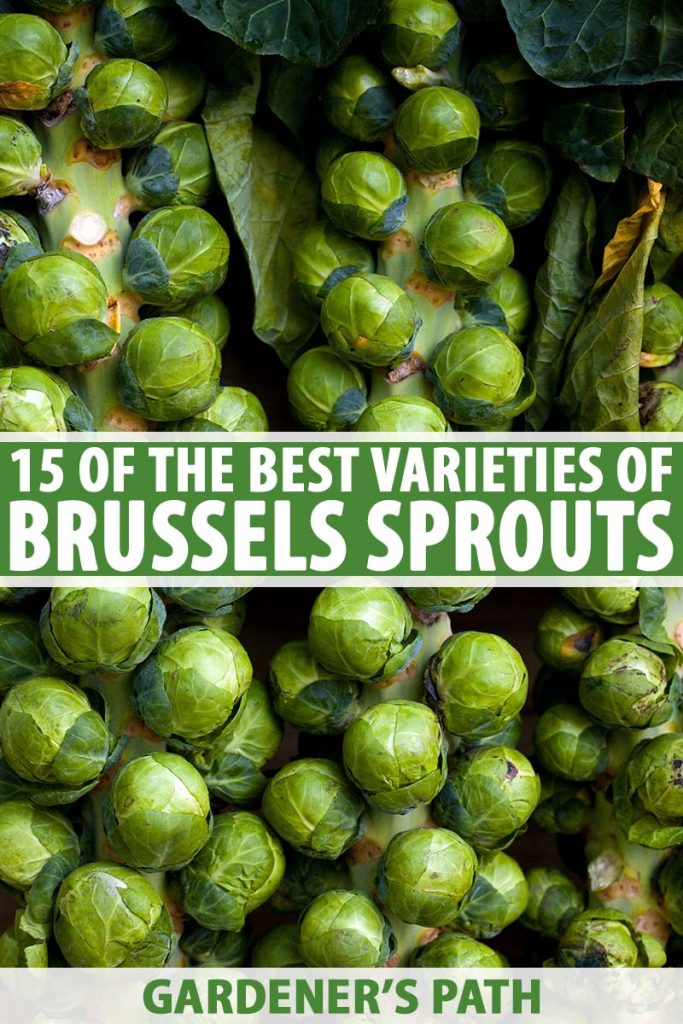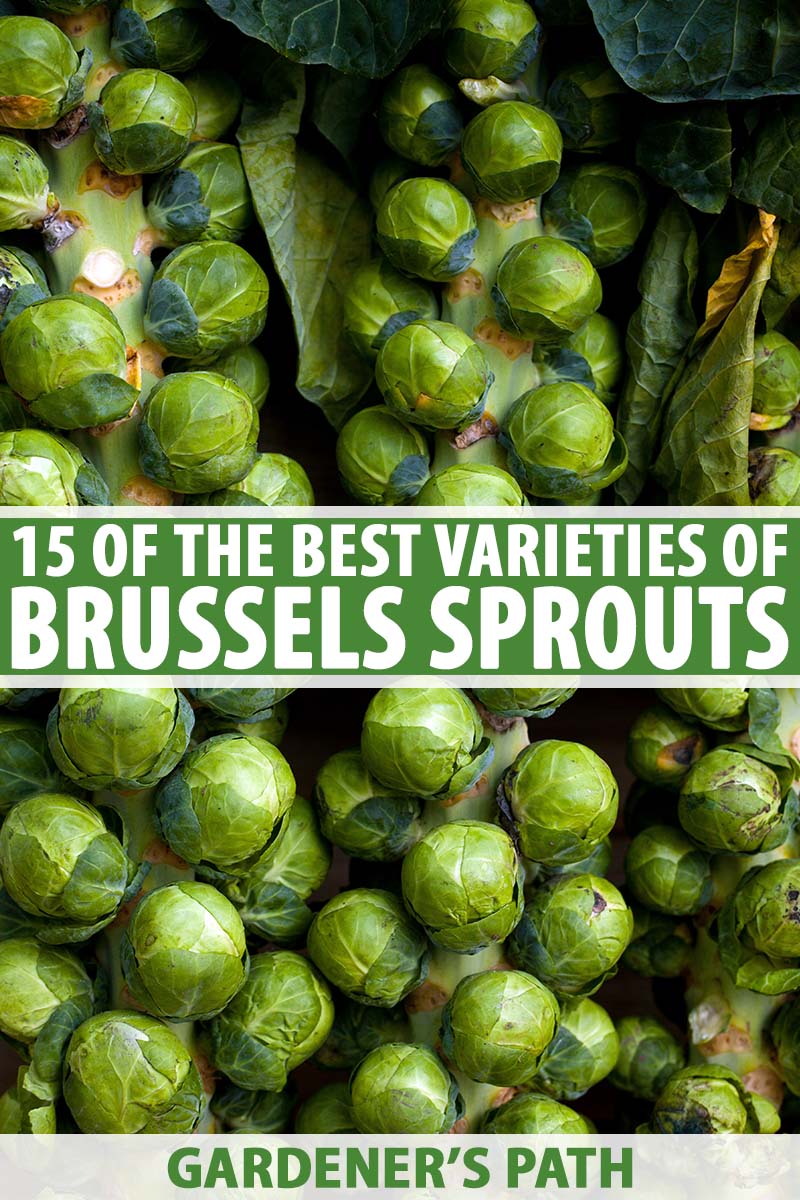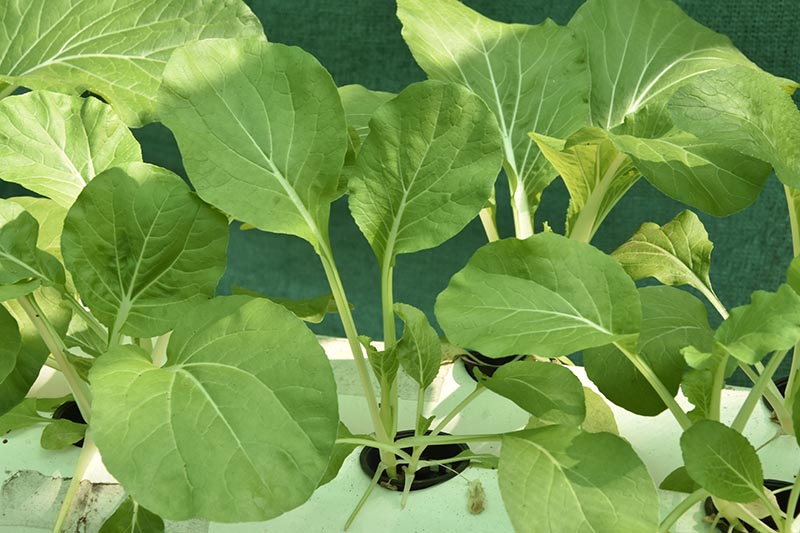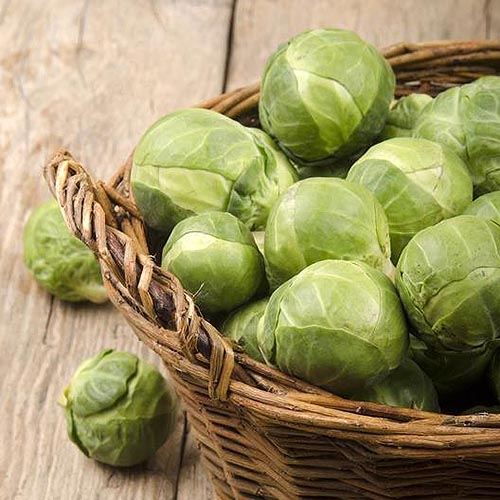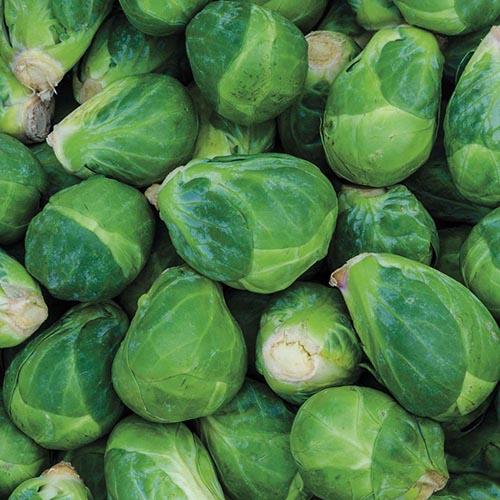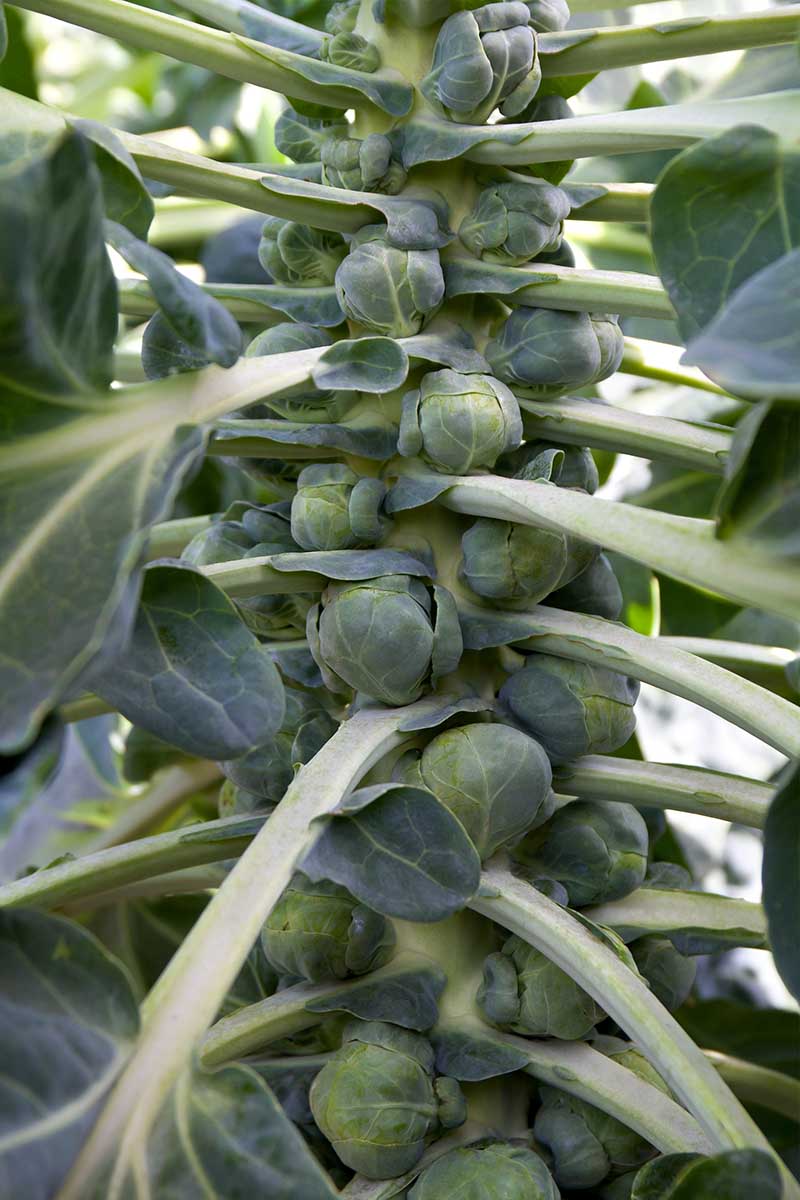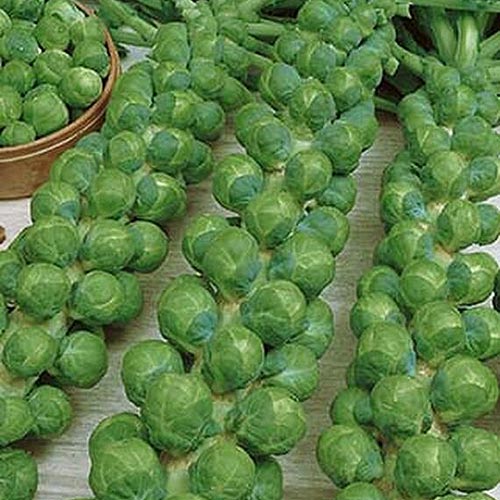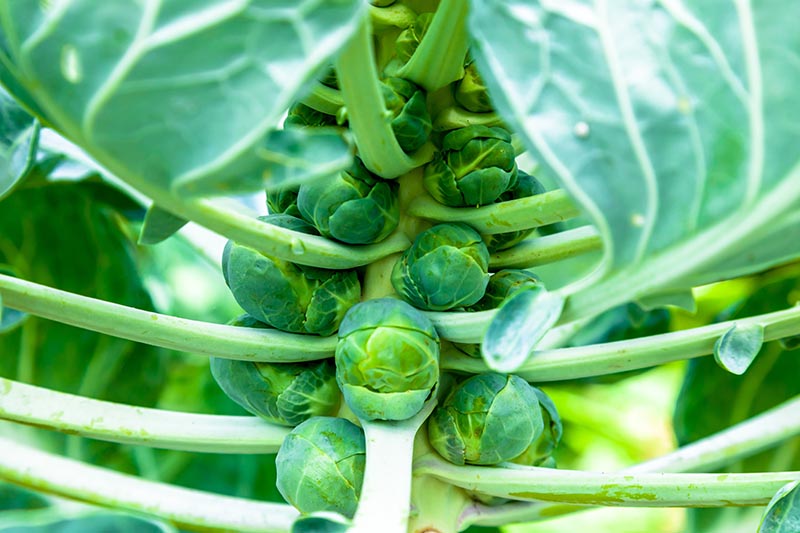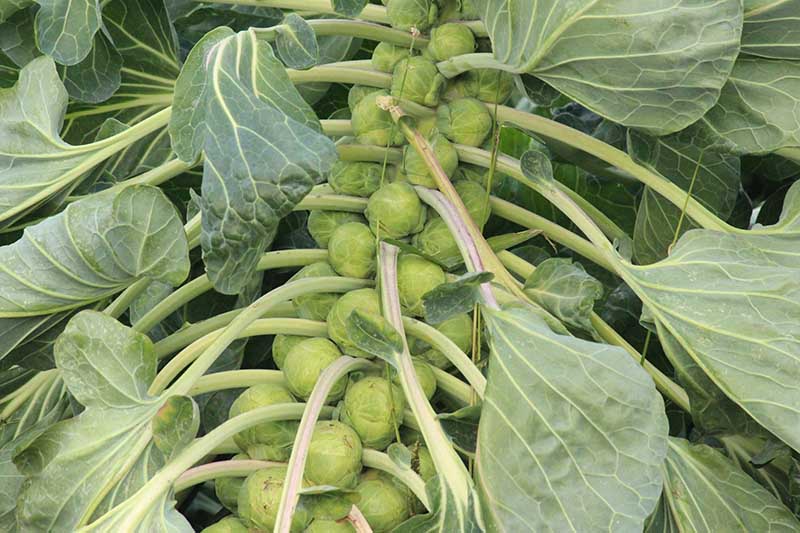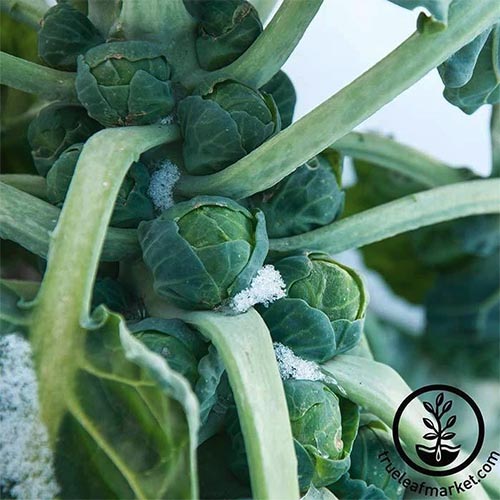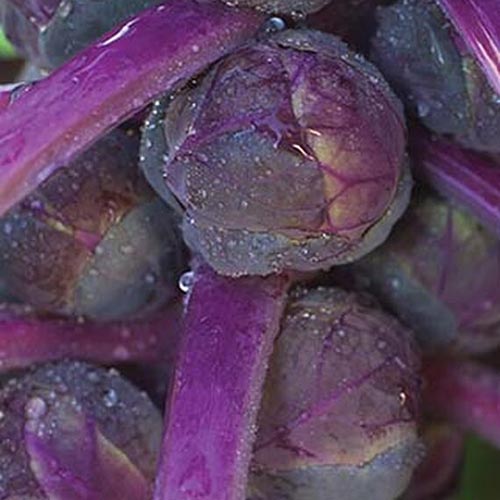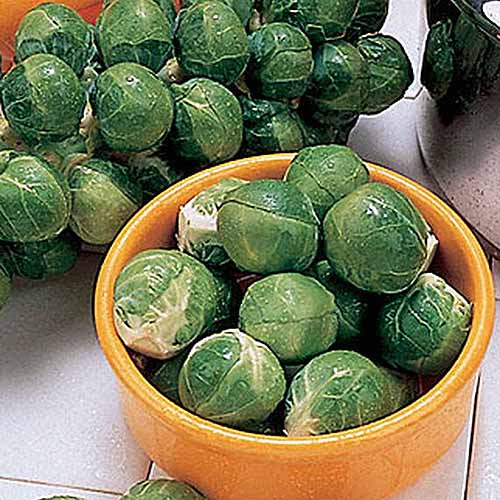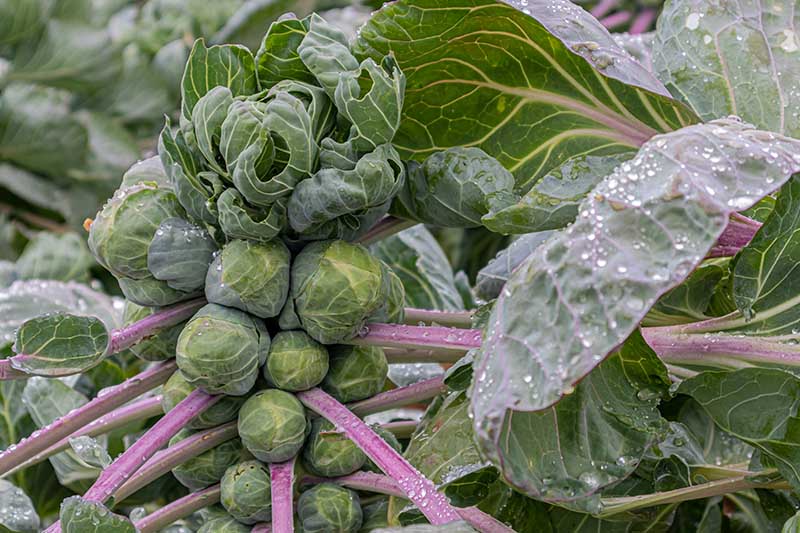Sure, you can buy these cruciferous treats year-round at the grocery store. I won’t lie, I enjoy them shaved into wispy threads and tossed with a vinaigrette in the summer. But they are so much more delicious pulled straight out of the garden after a frost than anything you’ll find at the supermarket. We link to vendors to help you find relevant products. If you buy from one of our links, we may earn a commission. All types of brussels sprouts (Brassica oleracea var. gemmifera) grow best in USDA Hardiness Zones 3-9, and all need cool weather to shine. But there is a subtle variation among the different cultivars that may surprise you. For instance, some produce stalks that are studded with tiny, crowded buds, while others are massive and well-spaced. Some have an earthy flavor reminiscent of root veggies, while others are distinctly buttery. There are brussels sprouts for those who struggle with mildew in their gardens, and varieties for people who worry about wind gusts wreaking havoc on their harvest. Brussels are available in a wide variety of colors and sizes, from pale green to dark emerald or even reddish-purple, and tiny little button buds under an inch in diameter to two-inch “loose” sizes. In this guide, we’ll cover 15 varieties. Each one stands out as a top pick, with its own unique set of characteristics.
1. Catskill
‘Catskill’ is an heirloom developed in 1941 by Arthur White in upstate New York. Though it’s a newish variety compared to some, it has earned a dedicated following thanks to its extra-large two-inch heads on a compact 24-inch stalk.
Speaking of stalks, you don’t have to worry about your sprouts overwhelming this one. This plant’s robust stem could practically double as a baseball bat. I like to picture old Arthur playing a pickup game of baseball with his grandkids, using sprouts as the ball and the stalks as the bat, but I have been accused of being overly imaginative with my crops. Regardless of whether you need to go on a little narrative journey like the one I’ve provided to be convinced that this cultivar is worth your while, the little heads will win you over with their rich flavor, and texture that holds up well to freezing. While you may not get a massive harvest with this variety – since each stalk only holds about 10 buds – the well-spaced sprouts make the plant less likely to contract Alternaria, thanks to the good airflow.
‘Catskill’ The plants take anywhere from 90 to 110 days to mature. Sold? Head to Eden Brothers to get your hands on some seeds.
2. Churchill
This hybrid grows fast and develops early, and here’s why that matters: Brussels sprouts sometimes don’t produce good yields if they develop too late in the spring growing season, because that’s when the weather can become unexpectedly hot. And nothing makes a brussels sprout more miserable than heat. Typically, springtime planting is only recommended in cooler growing zones, and planting for a fall harvest is preferred in other zones. With ‘Churchill,’ you can expect high yields with heads that develop early, and mature in just 90 days. And when I say high yields, I mean it – you can bring in over 14 ounces of veggies per plant, which is impressive.
‘Churchill’ You need to watch for lateral branching on this variety. These branches reduce airflow, which may invite disease. If this variety sounds like your jam, you can find seeds available at Home Depot.
3. Dagan
‘Dagan’ grows straight and tall, which is perfect if you’re looking for a bouquet of sprouts for your dinner table or farmers market stand. On top of that, the little buds are bright green and firm, so they hold up well after harvest.
This hybrid variety takes 100 days to mature and the sprouts hold well in the garden too, so you won’t ruin your harvest if you don’t get to them right away. One of the nice things about this one is that the buds attach to the stalk with just a tiny little nub. That means they snap off of the plant easily, and don’t have a big base that you’ll need to trim away when you’re ready to eat them. The solid stalks won’t tip over, an unwelcome occurrence known as lodging. This cultivar has good disease resistance as well.
4. Diablo
Get ready to give the devil its due. This pretty hybrid plant grows two feet tall and produces smooth, solid, medium-sized heads.
It’s extremely reliable and consistent, with a uniform growth habit. Expect large yields of sprouts that are devilishly delicious. When the plant is hit by a frost, the buds turn incredibly nutty and sweet – perhaps like Beelzebub himself will, once hell freezes over? The plant is slow to mature, taking around 110 days, so it may lend itself better to growing in the fall rather than the spring, particularly in warmer zones. That way, you can avoid the early heat that may destroy spring crops that stick around in the garden for too long. ‘Diablo’ You can also start seeds early indoors if you just can’t wait for fall, and transplant seedlings as soon as you can work the ground in the spring.
5. Green Gems
I love the name of this sprout because it so perfectly describes this variety. These little one-and-a-half-inch buds practically glow from within like emeralds in the sunlight. When you slice them open, you’re greeted by a cheerful yellow interior. Let’s face it, all brussels sprouts are delicious, but these are particularly good. They have a buttery, earthy flavor that needs nothing more than a drizzle of oil and some salt and pepper.
‘Green Gems’ Ready to harvest in just 85 days, the hybrid plants reach up to 36 inches tall, and you get plenty of veggies on one stalk. You may want to stake them to keep them upright, particularly if you live in an area with high winds. Grab a handful of these little ‘Green Gems’ (in seed form) from Burpee.
6. Gustus
‘Gustus’ is newer on the scene, but it’s quickly making a name for itself as a hybrid cultivar that deserves a spot in your garden.
Medium-sized sprouts grow on a 24-inch stalk. The one-and-a-half-inch buds are evenly spaced, with a lovely dark green color. The little veggies are dense and sweet. You need to plan ahead with this one, because it takes 100 days to mature. Once you harvest them, however, they’ll last a good long while in the fridge. I don’t want to admit how long I let mine linger in the refrigerator one year, but let’s just say the pages of my calendar definitely flipped more than once. If you are experimenting with new types, even though this one isn’t as popular on the brussels sprout scene, give it a chance.
7. Hestia
There’s a general rule with brussels sprouts: the early maturing varieties tend to not hold well in the garden. But that’s not the case with ‘Hestia.’
Another plus? The short stalks won’t tip over. As if that’s not enough to recommend it, this is only the second brussels sprout variety to win the All-America Selections (AAS) award in the vegetables category, in 2015. The bright green buds have a buttery yellow interior and they grow uniformly on the stalk. While all sprouts taste better after they experience a frost, this hybrid type doesn’t need to get as cold as some others to develop that sweet flavor. Just a light frost will make them perfect. ‘Hestia’ takes 95 days to mature.
8. Jade Cross
Sometimes you want a bunch of giant veggies for your dinner table, and sometimes you want them to be a bit more bite-sized.
‘Jade Cross’ has deep green, tiny little sprouts that grow anywhere from half an inch to an inch wide. If you want to freeze your veggies, this is the type to choose, both because the buttons keep their flavor and can even improve after hanging out in the freezer, and because their size is ideal for freezing solid quickly. It was the first brussels sprout variety to nab the All-America Selections award in 1959. ‘Jade Cross’ The hybrid plant is disease resistant and, because it grows with a compact habit, it doesn’t tip over as easily as some of the taller varieties. It matures relatively quickly, in about 85 days.
9. Long Island Improved
All brussels sprouts do well in cold weather, but ‘Long Island Improved’ is highly tolerant of frost, which only serves to improve the flavor of your harvest. Perhaps that’s why this is the most common variety on the market today. And for good reason – the medium-sized heads of this heirloom variety have a nutty, earthy, buttery flavor that’s pretty hard to beat.
‘Long Island Improved’ They’ll be ready for roasting in 100 days. If you want to try this particularly tasty variety, you can find seeds available at True Leaf Market.
10. Mighty
These picture-perfect little veggies have a lovely deep green color and a robust, nutty flavor packed into a small, one-inch package. If you’re looking for a sprout you can display on your holiday table for a feast, this is it. In addition to the uniform round heads, they also grow evenly-spaced. Lop the stalk off at the base and use it as a centerpiece on your table.
‘Mighty’ Even better, they have resistance to mildew, leaf spot, and Alternaria. This hybrid is ready to harvest in 100 days. You can find seeds available at Burpee.
11. Nautic
If you want to harvest a ton of veggies from just one plant, ‘Nautic’ is the way to go. This hybrid cultivar provides consistently high yields of around 12 ounces per plant. The buds are ready to harvest in 120 days, at which point you’ll be greeted by tender, sweet treats. But the thing that really makes this variety stand out is that the heads are well-spaced on the stalk, so they get plenty of air circulation to help avoid disease problems. This type is disease resistant, particularly to powdery mildew – the bane of so many garden plants!
12. Nelson
I think this hybrid variety deserves a more exciting name. Something like Pocket Explosion, or Pint-Sized Surprise. That’s because it rewards your growing efforts with tons of dark green buds that are filled with a surprisingly intense, sweet, nutty flavor. A cream-colored interior is tightly packed inside the smooth leaves. ‘Nelson’ resists lodging, though it is susceptible to Alternaria. The buds are evenly spaced and they mature early, in a mere 90 days.
13. Octia
This is one of the earliest-maturing varieties, coming in at a mere 78 days – tied with ‘Tasty Nuggets,’ described below. It has small one-inch heads that are extremely uniform. You get lots of veggies on one plant, and topping is said to increase the ultimate size of harvests even more. Topping is the process of cutting off the topmost tip of the plant to discourage it from growing taller. In theory, at least, this produces increased yields and larger sprouts.
‘Octia’ ‘Octia’ is a hybrid and produces well-spaced buds on a stalk that grows up to 36 inches tall, which discourages Alternaria thanks to good airflow, and makes the harvest super easy. Head to Burpee to pick up some seeds for your garden plot.
14. Redarling
Want a brussels sprout that will really stand out on the kitchen table? ‘Redarling’ has purple-red heads that grow one and a half inches across. They hold their color whether you steam or roast them, and they look so pretty that you might just convince the kids that sprouts are something to love, after all. This hybrid cultivar takes a long time to mature, however, so be sure to plan ahead! The purple heads are ready to pick in 140 to 145 days, and this cultivar is best suited to cooler growing zones.
‘Redarling’ Ready to please not only your tongue, but your eyes as well? You can find seeds or transplants available from Burpee.
15. Tasty Nuggets
Do you favor sweet sprouts? The name of this hybrid says it all. These tasty little nuggets pack a ton of flavor into a one-inch button. Plus, you get a large harvest on the compact 24-inch plants.
‘Tasty Nuggets’ Oh, and did I mention that you get all that in just 78 days? With such a short number of days to maturity, you should be able to grow these even in warmer zones without fear of bolting. Want to grow some in your garden? You can find seeds at Burpee.
There Are So Many Ways to Love This Flavorful Powerhouse of Nutrition
When we talk about brussels sprouts, most people can’t resist mentioning how maligned this cabbage-like veggie is among kids. I think that’s often due to poor preparation and poor presentation. Okay, and their flavor can be a bit complex for sensitive young palates. But I know that if my mom had presented me with a stalk of brussels sprouts that we got to play with before we roasted the heads with some butter, I might have had an entirely different take on them when I was young. Best-Brussels-Sprout-Varieties-Cover That’s one of the reasons I love growing sprouts. They taste incredible, sure, but they’re also undeniably interesting in the garden. If you have room, I think you should plant multiple varieties so you can have all kinds of sizes suited to different culinary uses, and different maturation dates for a continuous supply. Then, come back here and tell me which ones you or your loved ones enjoyed the most in the comments below! And for more information about growing brussels sprouts in your garden, check out these guides next:
Tips for Growing Brussels Sprouts in Winter Common Brussels Sprout Pests: What’s Eating My Plants? Pruning Brussels Sprouts: Tips for Success
